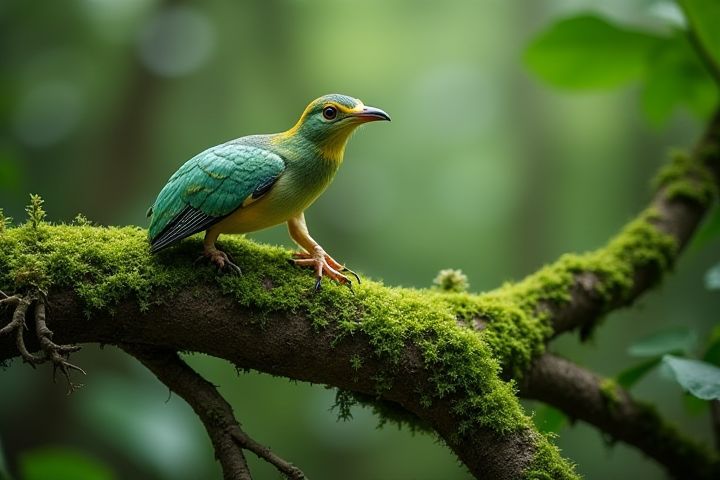
Nigerian woodlands, a crucial part of the country's diverse ecosystems, primarily consist of savannah and shrubland areas. These woodlands are home to a variety of flora and fauna, including endemic species like the West African manatee and various birds, contributing to Nigeria's rich biodiversity. Key tree species such as acacia, baobab, and shea provide vital resources for local communities, including timber and non-timber products. These ecosystems play an essential role in combating desertification and maintaining soil fertility, important for subsistence farming. Preservation efforts are critical as human activities and climate change threaten the sustainability of these woodlands.
Tropical climate
Nigerian woodlands, characterized by a tropical climate, showcase a diverse array of flora and fauna adapted to this unique environment. Dominated by open savanna and deciduous forests, these regions experience distinct wet and dry seasons, significantly influencing vegetation growth and ecosystem dynamics. Species such as baobab trees, acacias, and various grasses thrive in these conditions, providing crucial habitat for wildlife, including antelopes and numerous bird species. Understanding the interplay between climate and biodiversity in Nigerian woodlands is essential for conservation efforts and sustainable land management practices.
Biodiverse ecosystems
Nigerian woodlands are characterized by their rich biodiversity, hosting numerous species of flora and fauna, many of which are endemic. These ecosystems play a crucial role in maintaining environmental stability, providing habitat for wildlife, and supporting the livelihoods of local communities through resources such as timber and non-timber products. The interaction between various species promotes ecological balance and aids in carbon sequestration, contributing to climate regulation. Conservation efforts are vital to protect these woodlands from deforestation and habitat degradation, ensuring their continued contribution to Nigeria's ecological health and economic sustainability.
Dense rainforests
Nigerian woodlands encompass diverse ecosystems, predominantly characterized by dense rainforests notably located in the southeastern regions, such as Cross River and Akwa Ibom. These rainforests are rich in biodiversity, home to various flora including towering mahogany trees, ebony, and numerous medicinal plants. The fauna is equally impressive, with endangered species like the Cross River gorilla and the forest elephant found within these habitats. Your exploration of these vibrant ecosystems reveals their crucial role in carbon sequestration and the overall health of the global environment.
Savanna regions
The Nigerian woodlands primarily consist of diverse ecosystems, with the Savanna regions being a prominent feature. These Savannas are characterized by a mix of grasslands interspersed with trees, providing habitats for various wildlife, including elephants, antelopes, and a multitude of bird species. The climate in these areas is typically tropical, marked by distinct wet and dry seasons which influence the biodiversity and growth patterns of flora. You can explore how indigenous communities utilize these resources sustainably, highlighting traditional practices in agriculture and land management to preserve ecological balance.
Threatened by deforestation
Nigerian woodlands, a vital ecosystem rich in biodiversity, are currently threatened by extensive deforestation due to logging, agricultural expansion, and urbanization. These woodlands support numerous species, including endangered flora and fauna, while also playing a crucial role in carbon sequestration and climate regulation. The loss of these habitats results in soil degradation, disruption of water cycles, and increased greenhouse gas emissions. To protect these vital environments, sustainable practices and conservation efforts are essential for maintaining the ecological balance and preserving the unique wildlife that depends on these woodlands.
Home to rare species
Nigerian woodlands, characterized by diverse ecosystems, serve as habitats for rare and endangered species such as the chimpanzee and West African manatee. These unique biomes feature a mix of savannah and forest, providing a critical environment for biodiversity conservation. Your exploration of these regions can reveal endemic flora, including medicinal plants crucial for local communities. The ongoing conservation efforts aim to protect these fragile ecosystems from deforestation and climate change, emphasizing the need for sustainable management practices.
Contains carbon sinks
Nigerian woodlands serve as vital carbon sinks, playing a critical role in mitigating climate change. These diverse ecosystems, which include savannas and forests, store significant amounts of carbon dioxide through the process of photosynthesis. The rich biodiversity found within these woodlands contributes to their resilience and the overall health of the environment. Protecting and sustainably managing these areas is essential for maintaining their carbon storage capacity, benefitting both local communities and global efforts to combat greenhouse gas emissions.
Subject to conservation efforts
Nigerian woodlands, characterized by diverse flora and fauna, cover significant areas of the country's landscape and play a crucial role in supporting biodiversity. These ecosystems face threats from deforestation, agricultural expansion, and urbanization, prompting various conservation efforts aimed at preserving their ecological integrity. Initiatives such as reforestation projects and community-based conservation programs harness local participation to protect these vital habitats. By investing in sustainable land management practices, you contribute to the preservation of Nigeria's unique woodlands and their essential ecological services.
Source of traditional medicine
Nigerian woodlands serve as a rich source of traditional medicine, harboring a diverse array of medicinal plants utilized by local communities for centuries. Species such as *Moringa oleifera*, known for its nutritional and therapeutic benefits, and *Richardia scabrida*, used for digestive ailments, highlight the importance of these ecosystems. Herbalists and practitioners of traditional medicine rely heavily on the indigenous flora found in these woodlands, which provide natural remedies for common illnesses like malaria and respiratory infections. Preserving these habitats is essential, not only for maintaining biodiversity but also for ensuring that traditional healthcare practices continue for generations to come.
Vital for local livelihoods
Nigerian woodlands are crucial for local livelihoods, providing a diverse range of resources such as fuelwood, timber, and non-timber forest products like nuts and medicinal plants. These ecosystems support the agricultural economy, as they are essential for traditional farming practices and sustainable land use. The biodiversity within these woodlands fosters ecological balance, making them vital for soil health and water retention, which are critical for crop production. Engaging in sustainable management practices ensures that these resources remain available for future generations, enhancing both environmental resilience and community well-being.
